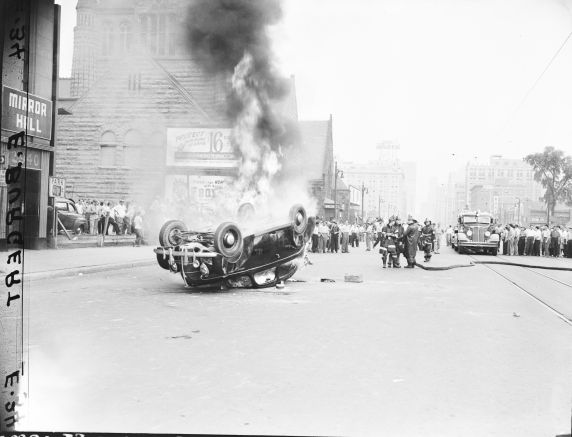The 1943 Detroit Race Riot
- Detroit (Mich.) -- Riot, 1942
- Detroit (Mich.) -- Riot, 1943
- Detroit--economic conditions
- Detroit--politics and government
- Detroit--race relations
- Detroit--social conditions
- Discrimination in housing--Michigan
- Housing
- Housing development--Michigan--Detroit
- Jeffries, Edward, 1900-1950
- Race relations
- Race riots
- Racism
- Urban Affairs
- World War, 1939-1945
On June 20, 1943, a fight broke out between African American and white Detroiters spending their Sunday on Belle Isle, the city’s large park in the middle of the Detroit River. Fighting spread to the mainland, and rumors crisscrossed the city, stoking racial tensions that had been running high and threatening to boil over into violence for months. Rioting spread, with little attempt from the police to stop it (in fact, much evidence points to many white police facilitating and even participating in violence against African Americans), and by the time President Franklin Roosevelt sent in federal troops on the evening of June 21, hundreds had been injured, and 34 people had died: 25 African American (17 of whom were shot by police), and 9 white. Of the arrests made later, 85% were African American.
Many factors contributed to the tension that was finally released during the 1943 Race Riots. With America’s entry into World War II, Detroit’s auto factories were converted to manufacturing material for the war effort. As a result, Detroit experienced a large population influx of people from around the country to fill the jobs created by the War’s demand. Between 1940 and 1943, Detroit’s population increased by about 500,000—roughly a third of its previous population. Many of the newcomers were white southerners who often brought a tradition of discrimination against African Americans with them. Blacks also flocked to the city, and frequently there was competition for jobs.
At the same time, the United Auto Workers (UAW) was gaining steam in its efforts to organize the factory workers. The UAW supported racial equality, and advocated for members of all races. Despite this support, resentful white workers often called strikes when black workers earned promotions. These walkouts over African American advancement contributed to the racial tension in the city.
Housing presented another issue. For years, blacks had been mostly isolated in a few neighborhoods in the city such as Black Bottom and Paradise Valley. The housing in these slums was abysmal, and extremely overcrowded. Especially as the population grew, people needed more and more adequate housing. In 1941, the federal government decided to build a housing project in northwest Detroit for African American defense workers called the Sojourner Truth Housing Project. Agitation from the white community convinced the government to change the project to accommodate white tenants instead. This switch elicited an outcry not just from civil rights advocates and the African American community, but also from Mayor Edward Jeffries. The government again reversed its decision, handing the project back to black tenants. When move-in day came at the end of February 1942, white crowds subjected the African American families to harassment and violence. Eventually, security forces were deployed in April to intimidate the white provocateurs, and finally African American families began occupying the housing project. Many see this incident as a precursor to the Riots of 1943.
The UAW and others fighting for racial equality often called on patriotism as a rallying point. It was often lamented that such racial animosity only fuels the Axis powers who can then state that the Allies are no more tolerant than they. Further, issues presented by lack of housing and the Riots themselves were often quantified in the number of man-hours lost by the War effort.
While other factors such as political corruption, lack of African American representation in the police force, lack of adequate recreation facilities, and racist agitators contributed to the 1943 Riots, competition for jobs and housing played the largest roles. In late 1943, as a response to the Riot, Mayor Jeffries appointed the Interracial Committee to make recommendations designed to improve governmental services that affect race relations; to investigate and address situations of discrimination and racial tension; and to produce informational programs to increase mutual understanding within the community.
Those interested in further researching the 1943 Race Riots in Detroit can find many resources at the Reuther Library. Photos from the event and its aftermath can be seen in our image gallery, and an overview can be found in our vertical file. The Lewis B. Larkin Papers, the NAACP Detroit Branch Records, and the Detroit Commission on Community Relations (DCCR)/Human Rights Department Records—which evolved from the Interracial Committee—all provide insight into the 1943 Riots. The Charles A. Hill Papers offer information on the 1942 Sojourner Truth Housing Project.
Johanna Russ was the Archivist for the American Federation of State, County, and Municipal Employees (AFSCME) from 2008 until 2013.
- jruss's blog
- Login to post comments
- Printer-friendly version






 Reddit
Reddit Facebook
Facebook LinkedIn
LinkedIn